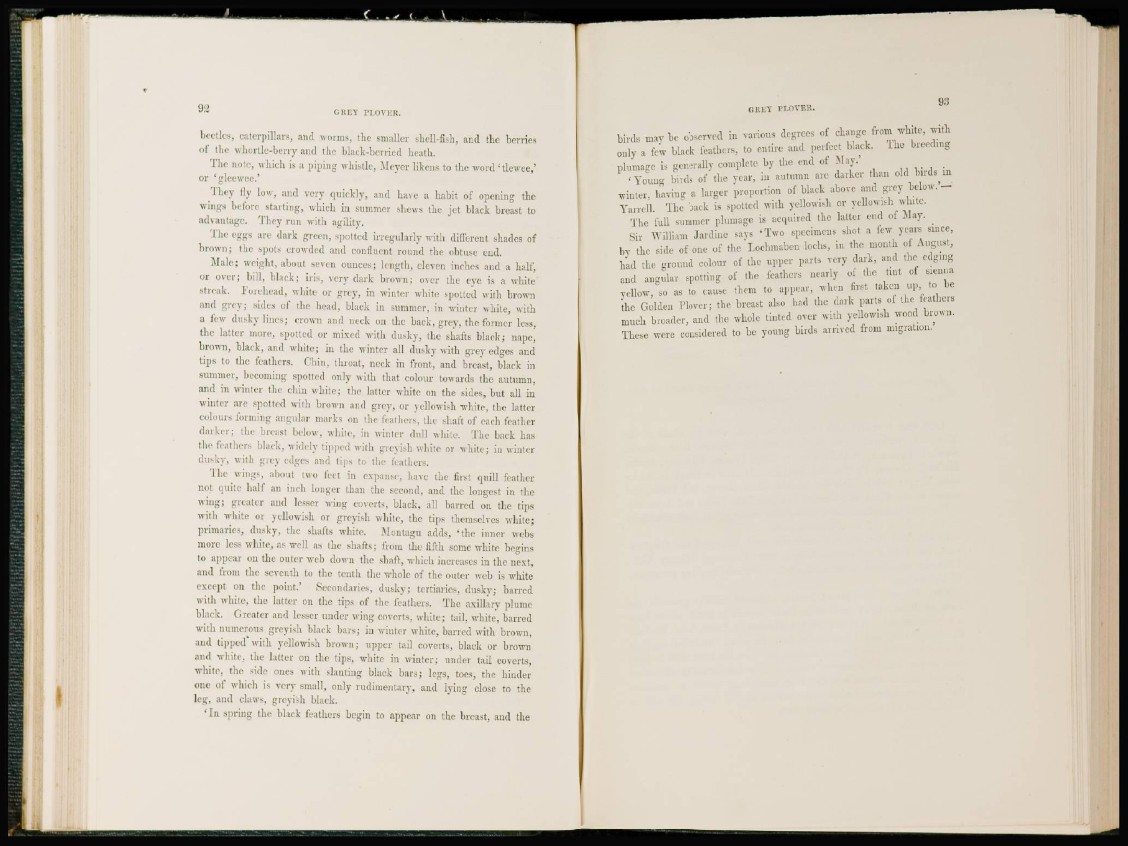
92 (• REÍ PLOVER.
beetles, caterpillars, and worms, the smaller shell-fish, and the berries
of the whortle-berry and the black-berried heath.
The note, which is a piping whistle, Meyer likens to the word f tlewce,'
or ' g l e e w e c'
They fly low-, and very quickly, and have a habit of opening the
w i n g s before starting, which in summer shews the jet black breast to
advantage. They run with agility.
The eggs are dark green, spotted irregularly with different shades of
brown; the spots crowded and confluent round the obtuse end.
Male; weight, about seven ounces; length, eleven inches and a half,
or over; bill, black; iris, very dark brown; over the eye is a white
streak. Forehead, white or grey, in winter white spotted with brown
and grey; sides of the head, black in summer, in winter white, with
a few dusky lines; crown and neck on the hack, grey, the former less,
the latter more, spotted or mixed with dusky, the shafts black; nape,
brown, black, and white; in the winter all dusky with grey edges and
tips to the feathers. Chin, throat, neck in front, and breast, black in
summer, becoming spotted only with that colour towards the autumn,
and in winter the chin white; the latter white on the sides, but all in
winter an1 spotted with brown and grey, or yellowish white, the latter
colours forming angular marks on the feathers, the shaft of each feather
darker; the breast below, white, in winter dull white. The back has
the feathers black, widely tipped with greyish white or white; in winter
dusky, with grey edges and tips to the feathers.
The wings, about two feet in expanse, have the first quill feather
not quite half an inch longer than the second, and the longest in the
wing; greater and lesser wing coverts, black, all barred on the tips
with white or yellowish or greyish white, the tips themselves white;
primaries, dusky, the shafts white. Montagu adds, ' t h e inner webs
more less white, as well as the shafts; from the fifth some white begins
to appear on the outer web down the shaft, which increases in the next,
and from the seventh to the tenth the whole of the outer web is white
except on the point.' Secondaries, dusky; tertiaries, dusky; barred
with white, the latter on the tips of the feathers. The axillary plume
black. Greater and lesser under wing coverts, white; tail, white, barred
with numerous greyish black bars; in winter white, barred with brown,
and tipped with yellowish brown; upper tail coverts, black or brown
and white, the latter on the tips, white iu winter; under tail coverts,
white, the side ones with slanting black bars; legs, toes, the binder
one of which is very small, only rudimentary, and lying close to the
leg, and claw-, greyish black.
' I n spring the black feathers begin to appear on the breast, and the
GREY PLOVER.
birds may be observed in various degrees of change from white, with
only a few black feathers, to entire and perfect black. The breeding
plumage is generally conqdete by the end of May.'
' Young birds of the year, in autumn are darker than old birds in
winter, having a larger proportion of black above and grey below.'—
Yarrell. The back is spotted with yellowish or yellowish white.
The full summer plumage is acquired the latter end of May.
Sir William Jar d i n e says 'Two specimens shot a few years since,
by the side of one of the Lochmaben lochs, in the month of August,
had the ground colour of the upper parts very dark, and the edging
and angular spotting of the feathers nearly of the tint of sienna
yellow, so as to cause them to appear, when first taken up, to be
the Golden Plover; the breast also had the dark parts of the feathers
much broader, and the whole tinted over with yellowish wood brown.
These were considered to be young birds arrived from migration.'